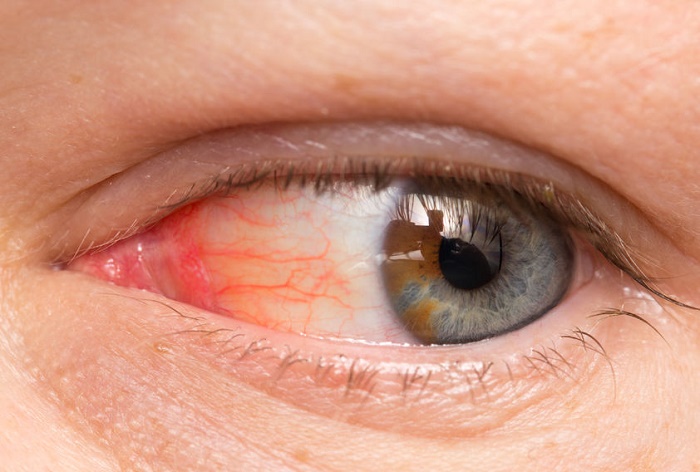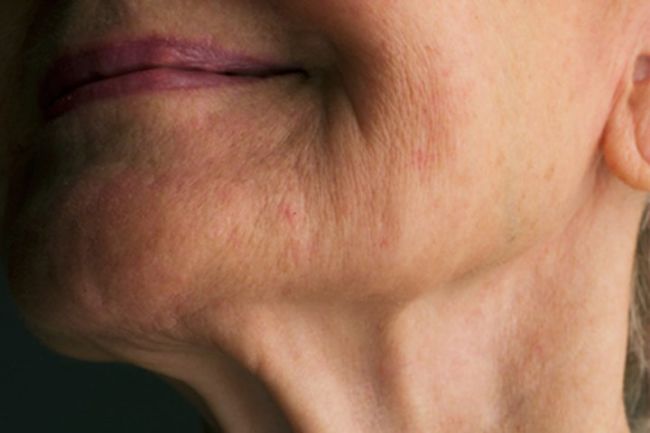Eye infections can affect any part of the eye including the inner or outer eyelid or eyeball. Eye infections can be caused by bacterial, viral or fungal infections, and any foreign body that enters the eye can cause severe irritation. Very often, people who wear contact lenses are more prone to eye infections. Common symptoms of an eye infection are redness around your eyelids, discharge, itching or itching in your eyes, watery eyes, and swelling around your eyes.

The eye is a very complex and sensitive organ; therefore, if you notice signs of a serious infection in your eye, you should consult an ophthalmologist. Not getting immediate treatment for an eye infection can lead to permanent eye damage and possible vision loss.
There are many folk remedies for eye infections, which can be used for mild infections or to supplement conventional treatment for severe eye infections. For example, a warm compress with chamomile can help reduce eye puffiness and is effective against pink eyes. Even a simple saline eye wash can help reduce eye infections, soothe irritation and speed up healing time.
Different types of eye infections
Before seeing the best home remedies for the treatment of an infected eye, it is important to know a little more about the different types of eye infections.
Eye infections can affect one or both eyes at the same time. Depending on the cause of the eye infection, you may have one of these eye infections:
Conjunctivitis or pink eye
This is a common viral or bacterial infection that affects the inside of the eyelid or the outer layer of the eye. Pink eyes cause itching, swelling, discharge and redness and can be very contagious.
Keratitis
It is a bacterial infection in the eye that can cause pain, vision problems, and watery eyes. Keratitis can also cause discharge and requires rapid medical treatment.
Herpes
Shingles can affect the eye, as well as make skin and nerves sensitive to touch. The Physicians (AAFP) says the herpes zoster virus can infect the skin around the eye and even the eye itself. This will cause your eye to become very painful, inflamed, and cause redness in the eyelid. If you have herpes around your eye, you should immediately consult with a doctor.
Blepharitis
Blepharitis causes the eyelids to become inflamed and also causes the skin around the eye to dry out. Your eyes will probably feel itchy and swollen. Some folk remedies are effective in treating blepharitis infections.
Orbital cellulite
A bacterial infection in the tissue around the eyes can cause orbital cellulite. The upper and lower eyelids swell and inflate and are often accompanied by fever, pain when moving the eye and decreased vision. If not treated, it can lead to blindness. Immediate medical attention for this type of eye infection is essential.
Eye stye
A stye is another common type of eye infection. A stye makes a red lump appear on the eyelid. Stye appears due to bacteria that block the oil gland on the eyelid. The lump may fill with pus and become red and swollen. A stye should disappear on its own within a few days.
Dacryocystitis
Dacriocystitis is an infection of the tear sac when blocked. Eye infection can inflame the area in the corner of your eye near your nose. This will probably be painful and may have flow from the corner of the eye.
Herpes
The same herpes virus that causes cold sores can also cause eye infections. Most often the infection spreads to the eye after touching a cold sore on the face. Herpes simplex virus (HSV) infection in the eye can cause pain, redness, vision problems, discharge, and sensitivity to light.
Common Symptoms of Eye Infections
A viral, bacterial, or fungal infection in or around your eye will cause a number of symptoms ranging from mild to severe. Mild eye infections can be treated effectively using folk remedies to reduce inflammation and help the eye heal properly.
Some symptoms of eye infections that can be treated at home are:
- A feeling of something in the eye.
- Redness around the eye or eyelids.
- A small amount of secretion.
- Watery eyes.
However, if you have other symptoms such as eye pain, increased sensitivity to light, fever, impaired vision and discharge, you should always be evaluated by a doctor.
Common Causes of Eye Infections
There are a number of reasons why the eyes become infected and cause redness, swelling and discharge. For example, irritation from a minor injury (such as a scratch) or a chemical that enters the eye can cause germs to cause an eye infection.
The Ophthalmology says people who wear contact lenses are more likely to have eye infections.
In addition, touching the eyes with dirty hands can spread germs and viruses to the eyes that can cause infections in the eyelids, eyeball, and tear sacs.
Home remedies for eye infections
Effective treatment for infections in and around the eye requires getting rid of the germs that cause the infection and soothing any inflammation. It is also important to always wash your hands before applying any remedy to the eye. This will help prevent the spread of any further infection to your eye.
Hot compress
A warm compress can treat an eye infection such as an eye stye or conjunctivitis and help cleanse the infection faster. The heat of the compress helps to increase blood flow to the infected eye which can speed up the healing process.
- Soak a clean, lint-free cloth in warm water and squeeze the excess.
- Keep your eyes closed and apply the warm compress to the infected eye several times a day.
- Repeat until the signs of your eye infection have completely disappeared.
If you have conjunctivitis in both eyes, you should wear different clean clothes for each eye. This is to prevent the spread of the infection from one eye to another. If your eye is inflamed, you can also try a fresh soothing compress for immediate relief from itching, and raspy eyes.
Tea bags
Tea bags are a great way to help treat an eye infection at home. Bags already used for eye infections, make excellent compresses, and tea contains soothing properties to help reduce inflammation and irritation caused by eye infections. Tea bags can also help drain pus from eye styes and prevent the infection from getting worse.
For example, green tea contains antioxidant and anti-inflammatory properties that can help treat various skin disorders.
- Dip a bag of green or black tea in hot water and leave it for 5 minutes.
- Press on excess moisture and make sure the tea bag isn’t hot.
- Place in your infected eye and hold for a few minutes at a time.
- Repeat the remedy with the tea bag every day until the irritation, discharge, and any other signs of infection in the eyes, are gone forever.
Chamomile
Chamomile is another natural remedy for the treatment of eye infections, especially pink eye and eye styes. The antimicrobial and anti-inflammatory properties of chamomile help to eliminate infections and soothe inflamed eyes.
Chamomile is used to eliminate tear gas infections, get rid of symptoms of conjunctivitis, and treat other eye disorders. A chamomile compress can help fight pink eye infections.
You can also make a therapeutic eye compress with chamomile tea bags to help get rid of eye infections. All you have to do is follow the instructions on regular use of tea bags for eye infections.
A word of warning: some people have an allergy to chamomile. Therefore, if you have allergic conjunctivitis, you should use an alternative natural remedy for your eye infection.
Bright eye (Euphrsia)
You can treat conjunctivitis naturally using a natural remedy called: bright eye (Euphrasia). The bright eye is a natural herb that has traditionally been used for the treatment of eye infections naturally. Also, it can help protect your eyesight and prevent vision problems.
A single drop of bright eye, 3 times a day can produce very good results when treating conjunctivitis. It is also effective for eye infections due to its antimicrobial properties.
The easiest way to use these drops as a natural remedy for eye infections is to buy it in homeopathy. Put a drop in your infected eye 3 times a day until the infection is completely gone.
Honey
The best type of honey for the treatment of eye infections is Manuka honey. However, if you can’t get it, you can also use organic honey as an effective natural eye ointment.
To help quickly reduce irritation and inflammation caused by an eye infection, use a little honey to speed healing
- Mix equal parts of honey with distilled water.
- Using a cotton ball, apply the natural remedy of honey to the infected eye.
- Use 2-3 times a day until the eye infection clears up and you no longer have any irritation.
Saline eye wash
You can relieve the discomfort in your eye from an eye infection by rinsing your eye with a saline solution.
- Mix 1 teaspoon of salt in a cup of water.
- Boil the salt solution and let it cool until it is hot.
- Use an eye bath to rinse the infected eye.
- Repeat by rinsing the eye with salt water 2-3 times a day until all symptoms of the eye infection are gone.
Colloidal silver
Some people have found colloidal silver to be a natural treatment for conjunctivitis or eye styes. Eye drops (also in cream) that contain colloidal silver can help eliminate eye infections.
You should buy colloidal silver from a health store or online.
- Put 1-2 drops of colloidal silver in your infected eye and blink to distribute the solution.
- Repeat 2 times a day.
- Continue to use until the eye infection clears up.
How to prevent eye infections?
Here are some practical ways to prevent infections in the eyelid, eyes, or area around the eye:
- Avoid touching your eyes and face. If necessary, wash your hands carefully before.
- When eye infections are treated, always wash your hands before and after applying remedies.
- Don’t share towels, face towels or pillows.
- Protect your eyes with glasses or glasses against dust, chemicals and other irritants.
- If you wear contact lenses, always take them off before you go to sleep and follow the instructions in the cleaning solution carefully.
Eye infections – When to see a doctor
Always consult a doctor promptly if your eye infection causes any of the following:
- Moderate or severe pain in one or both eyes.
- Redness in or around the eye becomes very intense.
- Symptoms of an eye infection do not improve within 24 hours of treatment at home.
- You develop sensitivity to light.
- Your vision is blurred or impaired.









